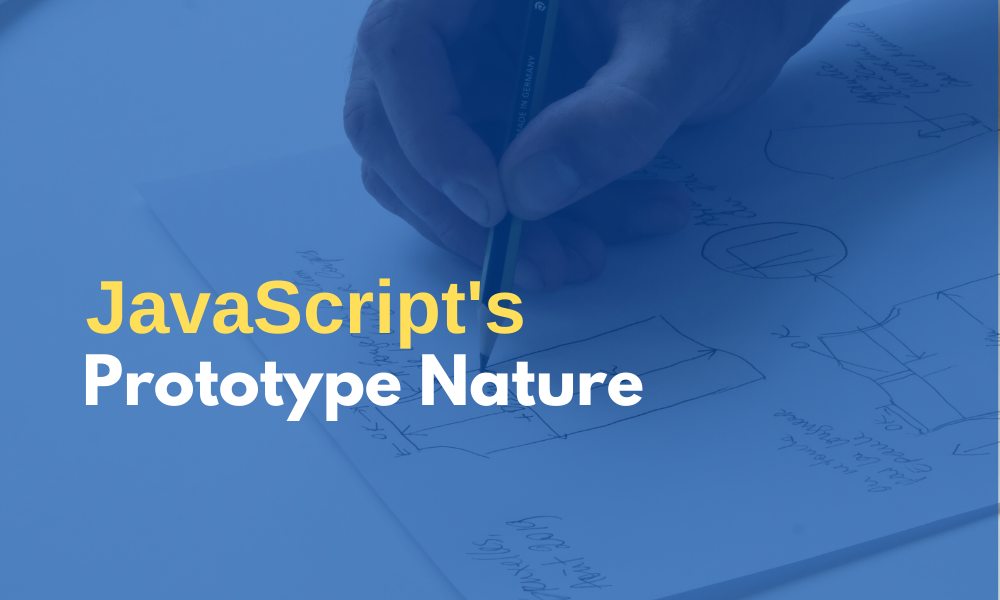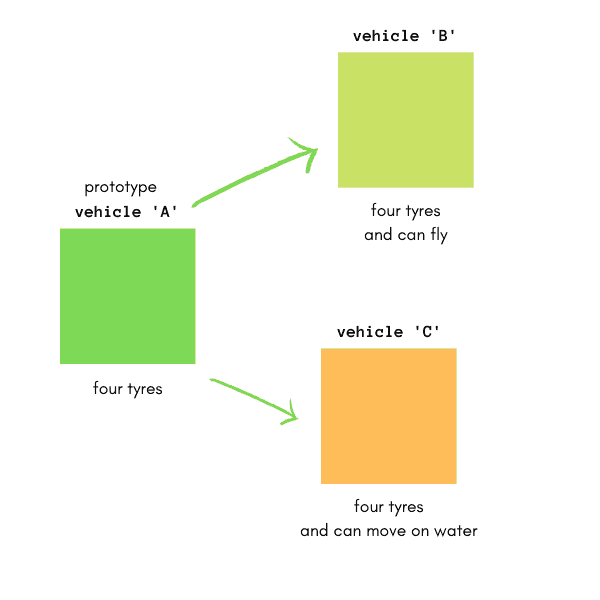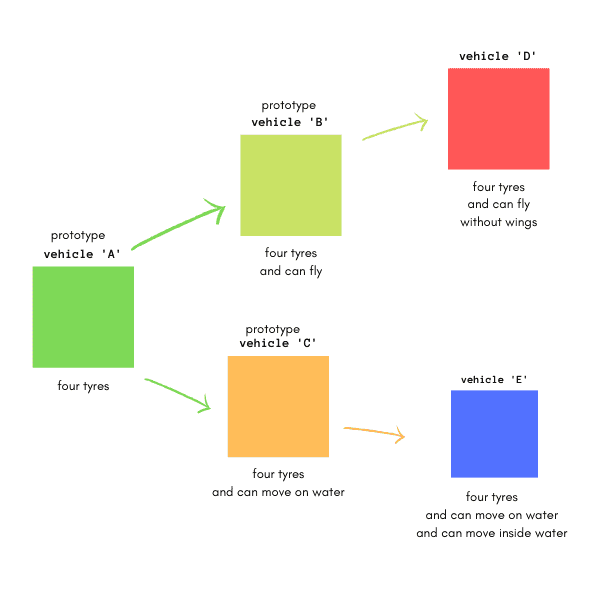Understanding JavaScript Prototype Nature and Prototype Chain
May 16th, 2020

JavaScript is a prototype-based object-oriented language. Although, you'd see the class keyword (in modern Javascript) but it works as prototypes at the background. I explained how the class keyword works in this article on this.
In this article, we'll look at the prototype nature of JavaScript, as well as the Prototype chain in objects.
Examine the following code:
const animals = {
name: "animal",
type: "object",
}
animals.hasOwnProperty("name")
// trueBut animals does not have a method called hasOwnProperty so why aren't we having undefined? By the end of this article, we'll understand how this works and more.
The concept of prototypes
A prototype according to the dictionary is:
a first or preliminary version of a device or vehicle from which other forms are developed.
A graphical example to best explain this, is this vehicle example in the diagram below:
The prototype 'A' is the first version from which other versions like 'B' and 'C' are created. In most cases, 'A' would contain the most essential features that a vehicle should have while 'B' and 'C' would contain more features for other use cases.
What this means is that, 'B' and 'C' are improved versions of 'A' but still contain features of 'A'. 'A' has four tyres, 'B' has four tyres and can fly, and 'C' has four tyres, cannot fly but can move in water.
JavaScript works on the basis of prototypes. At the declaration of every function, the JavaScript engine adds the prototype object property to that function which makes the function a prototype that other versions can be created from. You can confirm that with this example:
function hello() {
console.log("hello")
}
console.dir(hello)Result:
The result (as seen in the image above) shows the properties of the function hello which includes prototype. Another property called __proto__ can be seen. More on it later in this article.
The prototype object has two properties: the first being constructor and the other being __proto__ (again). The former points to the hello function while the latter points to Object.
The benefit of Prototypes
Prototypes makes it easy for functions to keep only one copy of features of which newer versions would have access to. This means that newer versions would not need to have their own copy, they could just focus on having more features which they'd need for their use case.
To explain this further, let's look at constructor functions, which is one way of creating objects.
function Hello() {
console.log("hello")
}
const anotherVersion = new Hello()
anotherVersion.type = "new"
console.log(anotherVersion)Hello with a capitalized first letter is a convention to show that a function would be used as a constructor function (that is, used to construct an object).
Result:
The result shows us now that anotherVersion is a new object built from Hello. This can be a great way of creating objects with an existing skeleton (how the object should look), but problems set in when you want similar objects to have the same features (do the same things) using the constructor function alone. For example:
function Obj(name) {
this.name = name
this.printName = function () {
console.log(this.name)
}
}
const javascript = new Obj("javascript")
const php = new Obj("php")
console.log(javascript)
// Obj {name: 'javascript', printName: f}
console.log(php)
// Obj {name: 'php', printName: f}The this variable used in Obj points to the object calling the function Obj (which in the above code is javascript and php). Learn more about this in this article
We can see that while php and javascript have different name values, they have the same function code. What if php never uses its printName function, that would result in memory wastage especially when many other objects are created from this constructor function.
With prototypes, you can create just one copy of printName and every object created from that prototype can have a different name value.
Remember above that hello had two properties: prototype and __proto__. prototype also had two properties: constructor (which pointed back to the function) and __proto__. When creating objects using the constructor function of Obj, the constructor property of the prototype property was used. This is the default function used when creating other objects. Let's check that with the following code:
function Obj(name) {
this.name = name
this.printName = function () {
console.log(this.name)
}
}
const javascript = new Obj("javascript")
console.log(javascript)Result:
From the image above, you'd see that the __proto__ (called dunder proto) property which connects to our prototype Obj (more on __proto__ later in this article) has a constructor which points to Obj(name) - our function. Confirmed!
Sharing features with prototypes
Now we know that the prototype property of a function makes that function a prototype that can be used for creating other objects.
What if the prototype property had other properties asides constructor and __proto__ since as we know, JavaScript properties can have new properties attached at any point in time? Let's see:
function Obj(name) {
this.name = name
this.printName = function () {
console.log(this.name)
}
}
const javascript = new Obj("javascript")
Obj.prototype.printType = function () {
console.log(this.type)
}
console.log(javascript)Result:
As seen in the image above, the __proto__ property now has a printType method but the object javascript itself does not have a printType method. Since javascript had access to the constructor function in the __proto__ property by default, then it would also have access to printType. Hence, the following would work correctly:
javascript.printType()
// undefined, because type does not exist
javascript.type = "language"
javascript.printType()
// languageHow does JavaScript do this? First it checks if the method exists on javascript and if it doesn't, it checks the __proto__ property.
Prototype Inheritance
This is the concept whereby an object inherits features from another object (which is the prototype). This relationship is shown on the __proto__ property.
The inheritance is not so literal as assumed, because the new object would not have that feature directly. Prototype inheritance actually means that the new object has access to the prototype's properties.
Prototype chain
Backtrack to the last image, you'd notice that __proto__ of javascript also has its own __proto__. As you may guess, this means that the object Obj which is used as a prototype, also inherits some features from another prototype. This is called the prototype chain.
This means that an object can be a new version of a prototype and at the same time be a prototype for another object. So, when you try to access a property on an object, JavaScript starts checking from the object to find the property, and if it doesn't, it continues checking the __proto__s all the way up until there is no __proto__ or the property is found.
undefined is returned when such property does not exist.
Wrap Up
Back to the first code block:
const animals = {
name: "animal",
type: "object",
}
animals.hasOwnProperty("name")
// trueThings should be clearer by now, right?
When you check the properties of animals in the console, you'll notice that it has a __proto__ pointing to the Object's prototype. And, the Object's prototype has hasOwnProperty property. animals inherited (has access to) that property and this makes it possible.
Object in JavaScript has a prototype which all objects inherit from. Constructors like Function, String and so on also inherit from Object. When a function is created (using the constructor or the literal method), it automatically has access to the Function's prototype properties (which also has access to Object - prototype chain).
This is what makes things like 'string'.toLowerCase() possible. The prototype object of String constructor has all of those properties, hence, string values can use them.
Thanks for reading : )






